Quantifying the Effects of Snow on the Beginning of Vegetation Growth in the Mongolian Plateau
Abstract
1. Introduction
2. Materials and Methods
2.1. Study Area
2.2. Data Sources
2.3. Methods
2.3.1. Snow Phenology Parameters
2.3.2. CASA Model
2.3.3. Cumulative Logistic Curvature Method
2.3.4. Path Analysis
2.3.5. Grey Relation Analysis
3. Results
3.1. Spatiotemporal Characteristics of SCFWinter and SMDSpring
3.2. Spatiotemporal Characteristics of Vegetation NPP and SOSNPP
3.3. The Relationship between SOSNPP and Driving Factors
3.4. Path Analysis of SOSNPP Changes in Snow Dynamics
4. Discussion
4.1. Possible Impact of the Cloud Snow Cover Product Data
4.2. Discussion of NPPSOS Results
4.3. Principle and Results of Path Analysis
4.4. SOSNPP Result and Influence Factors
5. Conclusions
- (1)
- Different vegetation types in the whole study area undergo similar changes in the SCFWinter, with a slow downward trend. In terms of spatial distribution, the spatial SCFWinter underwent a significant decrease of −0.2% from 2001 to 2019. The spatial distribution SCFWinter followed a decreasing trend from north to south.
- (2)
- The vegetation NPP in the broadleaf forest area reached a maximum value of 545.83 g·C/m2 in 2018, and its lowest value was 413.04 g·C/m2 in 2001. In terms of spatial distribution, the spatial NPP showed a significant increase of 1.95 g·C/m2 from 2001 to 2019. The spatial NPP diversity for different types of vegetation is obvious and shows decreasing trend from east to west.
- (3)
- With a path analysis, we highlight the correlation between the regional hydrothermal coupling relationship. The SOSNPP, TEMSpring, and PRESpring decreased significantly, as reflected in the path coefficients of −0.2 and −0.09 in the broadleaf forest SOSNPP, respectively. The TEMSpring has a significant negative effect on the SOSNPP in the Mongolia Plateau, with a path coefficient of −0.09.
- (4)
- With grey correlation analysis, it can be seen that different vegetation types have different effects on the SOSNPP in the Mongolian Plateau. The grey correlation degree of PRESpring to the forest vegetation-type SOSNPP reached a maximum of 0.65, and that of SCFWinter to steppe vegetation-type SOSNPP reached a maximum of 0.66. PRESpring, SMDSpring, TEMSpring, SMSpring and SCFWinter accounted for 21.26%, 21.11%, 20.72%, 20.12%, and 16.8% of the whole study area SOSNPP, respectively.
Author Contributions
Funding
Data Availability Statement
Acknowledgments
Conflicts of Interest
References
- Duda, M.P.; John, R.G.; Neal, M.; Gregory, J.R.; William, A.M.; Jennifer, A.K.; David, C.E.; Jules, M.B.; John, P.S. Long-Term Changes in Terrestrial Vegetation Linked to Shifts in a Colonial Seabird Population. Ecosystems 2020, 23, 1643–1656. [Google Scholar] [CrossRef]
- Li, L.; Zha, Y.; Zhang, J.; Li, Y.; Lyu, H. Effect of terrestrial vegetation growth on climate change in China. J. Environ. Manag. 2020, 262, 110321. [Google Scholar] [CrossRef] [PubMed]
- Zhao, Q.; Hao, X.; Wang, J.; Luo, S.; Shao, D.; Li, H.; Feng, T.; Zhao, H. Snow Cover Phenology Change and Response to Climate in China during 2000–2020. Remote Sens. 2022, 14, 3936. [Google Scholar] [CrossRef]
- Raza, A.; Razzaq, A.; Mehmood, S.S.; Zou, X.; Zhang, X.; Lv, Y.; Xu, J. Impact of Climate Change on Crops Adaptation and Strategies to Tackle Its Outcome: A Review. Plants 2019, 30, 34. [Google Scholar] [CrossRef]
- Numata, S.; Yamaguchi, K.; Shimizu, M.; Sakurai, G.; Morimoto, A.; Alias, N.; Azman, N.Z.N.; Satake, A. Impacts of climate change on reproductive phenology in tropical rainforests of Southeast Asia. Commun. Biol. 2022, 5, 311. [Google Scholar] [CrossRef]
- Stolaroff, J.K.; Pang, S.H.; Li, W.; Kirkendall, W.G.; Goldstein, H.M.; Aines, R.D.; Baker, S.E. Transport Cost for Carbon Removal Projects With Biomass and CO2 Storage. Front. Energy Res. 2021, 9, 639943. [Google Scholar] [CrossRef]
- Brown, R.D.; Mote, P.W. The Response of Northern Hemisphere Snow Cover to a Changing Climate. J. Clim. 2009, 22, 2124–2145. [Google Scholar] [CrossRef]
- Gong, G.; Entekhabi, D.; Cohen, J.; Robinson, D. Sensitivity of atmospheric response to modeled snow anomaly characteristics. J. Geophys. Res. Atmos. 2004, 109, D06107. [Google Scholar] [CrossRef]
- Assmann, J.J.; Myers-Smith, I.H.; Phillimore, A.B.; Bjorkman, A.D.; Ennos, R.E.; Prevéy, J.S.; Henry, G.H.R.; Schmidt, N.M.; Hollister, R.D. Local snow melt and temperature—But not regional sea ice—Explain variation in spring phenology in coastal Arctic tundra. Glob. Change Biol. 2019, 25, 2258–2274. [Google Scholar] [CrossRef]
- Musselman, K.N.; Molotch, N.P.; Brooks, P.D. Effects of vegetation on snow accumulation and ablation in a mid-latitude sub-alpine forest. Hydrol. Process. 2008, 22, 2767–2776. [Google Scholar] [CrossRef]
- Zhang, Y.; Wang, S.; Barr, A.G.; Black, T.A. Impact of snow cover on soil temperature and its simulation in a boreal aspen forest. Cold Reg. Sci. Technol. 2008, 52, 355–370. [Google Scholar] [CrossRef]
- Zheng, J.; Jia, G.; Xu, X. Earlier snowmelt predominates advanced spring vegetation greenup in Alaska. Agric. For. Meteorol. 2022, 315, 108828. [Google Scholar] [CrossRef]
- Wang, J.; Brown, D.G.; Chen, J. Drivers of the dynamics in net primary productivity across ecological zones on the Mongolian Plateau. Landsc. Ecol. 2013, 28, 725–739. [Google Scholar] [CrossRef]
- Liu, Y.; Fang, Y.; Li, D.; Margulis, S.A. How Well do Global Snow Products Characterize Snow Storage in High Mountain Asia? Geophys. Res. Lett. 2022, 49, e2022GL100082. [Google Scholar] [CrossRef]
- Sa, C.; Meng, F.; Luo, M.; Li, C.; Wang, M.; Adiya, S.; Bao, Y. Spatiotemporal variation in snow cover and its effects on grassland phenology on the Mongolian Plateau. J. Arid. Land 2021, 13, 332–349. [Google Scholar] [CrossRef]
- Ni-Meister, W.; Gao, H. Assessing the impacts of vegetation heterogeneity on energy fluxes and snowmelt in boreal forests. J. Plant Ecol. 2011, 4, 37–47. [Google Scholar] [CrossRef]
- Li, Y.; Fu, Q.; Li, T.; Liu, D.; Hou, R.; Li, Q.; Yi, J.; Li, M.; Meng, F. Snow melting water infiltration mechanism of farmland freezing-thawing soil and determination of meltwater infiltration parameter in seasonal frozen soil areas. Agric. Water Manag. 2021, 258, 107165. [Google Scholar] [CrossRef]
- Wang, L.X.; Gao, J.X.; Shen, W.M.; Shi, Y.L.; Zhang, H.W. Carbon storage in vegetation and soil in Chinese ecosystems estimated by carbon transfer rate method. Ecosphere 2021, 12, e03341. [Google Scholar] [CrossRef]
- Whittaker, R.H. Estimation of Net Primary Production of Forest and Shrub Communities. Ecology 1961, 42, 177–180. [Google Scholar] [CrossRef]
- Rupp, R.S.; Deroche, S.E. Standing Crops of Fishes in Three Small Lakes Compared with C14 Estimates of Net Primary Productivity. Trans. Am. Fish. Soc. 1965, 94, 9–25. [Google Scholar] [CrossRef]
- Hao, R.; Yu, D.; Huang, T.; Li, S.; Qiao, J. NPP plays a constraining role on water-related ecosystem services in an alpine ecosystem of Qinghai, China. Ecol. Indic. 2022, 138, 108846. [Google Scholar] [CrossRef]
- Xu, H.J.; Wang, X.P. Effects of altered precipitation regimes on plant productivity in the arid region of northern China. Ecol. Inform. 2016, 31, 137–146. [Google Scholar] [CrossRef]
- Yin, C.; Luo, M.; Meng, F.; Sa, C.; Yuan, Z.; Bao, Y. Contributions of Climatic and Anthropogenic Drivers to Net Primary Productivity of Vegetation in the Mongolian Plateau. Remote Sens. 2022, 14, 3383. [Google Scholar] [CrossRef]
- Hart, R.; Salick, J.; Ranjitkar, S.; Xu, J. Herbarium specimens show contrasting phenological responses to Himalayan climate. Proc. Natl. Acad. Sci. USA 2014, 111, 10615–10619. [Google Scholar] [CrossRef] [PubMed]
- Tenaw, G.; Jebessa Debella, H. Climate change and its effects on vegetation phenology across ecoregions of Ethiopia. Glob. Ecol. Conserv. 2017, 13, e00366. [Google Scholar] [CrossRef]
- Ding, M.; Li, L.; Zhang, Y.; Sun, X.; Liu, L.; Gao, J.; Wang, Z.; Li, Y. Start of vegetation growing season on the Tibetan Plateau inferred from multiple methods based on GIMMS and SPOT NDVI data. J. Geogr. Sci. 2015, 25, 131–148. [Google Scholar] [CrossRef]
- Moulin, S.; Kergoat, L.; Viovy, N.; Dedieu, G. Global-Scale Assessment of Vegetation Phenology Using NOAA/AVHRR Satellite Measurements. J. Clim. 1997, 10, 1154–1170. [Google Scholar] [CrossRef]
- Myneni, R.; Keeling, C.; Tucker, C.; Asrar, G.; Nemani, R. Increased Plant Growth in the Northern High Latitudes from 1981 to 1991. Nature 1997, 386, 698–702. [Google Scholar] [CrossRef]
- Jeong, S.J.; Ho, C.H.; Gim, H.J.; Brown, M.E. Phenology shifts at start vs. end of growing season in temperate vegetation over the Northern Hemisphere for the period 1982–2008. Glob. Change Biol. 2011, 17, 2385–2399. [Google Scholar] [CrossRef]
- Gao, S.; Liang, E.; Liu, R.; Babst, F.; Camarero, J.J.; Fu, Y.H.; Piao, S.; Rossi, S.; Shen, M.; Wang, T.; et al. An earlier start of the thermal growing season enhances tree growth in cold humid areas but not in dry areas. Nat. Ecol. Evol. 2022, 6, 397–404. [Google Scholar] [CrossRef]
- Pulliainen, J.; Aurela, M.; Laurila, T.; Aalto, T.; Takala, M.; Salminen, M.; Kulmala, M.; Barr, A.; Heimann, M.; Lindroth, A.; et al. Early snowmelt significantly enhances boreal springtime carbon uptake. Proc. Natl. Acad. Sci. USA 2017, 114, 11081–11086. [Google Scholar] [CrossRef]
- Qi, Y.; Wang, H.; Ma, X.; Zhang, J.; Yang, R. Relationship between vegetation phenology and snow cover changes during 2001–2018 in the Qilian Mountains. Ecol. Indic. 2021, 133, 108351. [Google Scholar] [CrossRef]
- Yu, Z.; Liu, S.; Wang, J.; Sun, P.; Liu, W.; Hartley, D.S. Effects of seasonal snow on the growing season of temperate vegetation in China. Glob. Change Biol. 2013, 19, 2182–2195. [Google Scholar] [CrossRef]
- Chen, X.; Liang, S.; Cao, Y.; He, T.; Wang, D. Observed contrast changes in snow cover phenology in northern middle and high latitudes from 2001–2014. Sci. Rep. 2015, 5, 16820. [Google Scholar] [CrossRef]
- Rihan, W.; Zhao, J.; Zhang, H.; Guo, X.; Ying, H.; Deng, G.; Li, H. Wildfires on the Mongolian Plateau: Identifying Drivers and Spatial Distributions to Predict Wildfire Probability. Remote Sens. 2019, 11, 2361. [Google Scholar] [CrossRef]
- Zhao, X.; Hu, H.; Shen, H.; Zhou, D.; Zhou, L.; Myneni, R.B.; Fang, J. Satellite-indicated long-term vegetation changes and their drivers on the Mongolian Plateau. Landsc. Ecol. 2015, 30, 1599–1611. [Google Scholar] [CrossRef]
- Sun, Y.; Zhang, T.; Liu, Y.; Zhao, W.; Huang, X. Assessing Snow Phenology over the Large Part of Eurasia Using Satellite Observations from 2000 to 2016. Remote Sens. 2020, 12, 2060. [Google Scholar] [CrossRef]
- Ryu, Y.; Jiang, C.; Kobayashi, H.; Detto, M. MODIS-derived global land products of shortwave radiation and diffuse and total photosynthetically active radiation at 5km resolution from 2000. Remote Sens. Environ. 2018, 204, 812–825. [Google Scholar] [CrossRef]
- Riggs, G.; Barton, J.; Casey, K.; Hall, D.; Salomonson, V. MODIS snow products user guide. NASA Goddard Space Flight Cent. Rep. 2006, 80, 1–45. [Google Scholar]
- Potter, C.S.; Randerson, J.T.; Field, C.B.; Matson, P.A.; Vitousek, P.M.; Mooney, H.A.; Klooster, S.A. Terrestrial ecosystem production: A process model based on global satellite and surface data. Glob. Biogeochem. Cycles 1993, 7, 811–841. [Google Scholar] [CrossRef]
- Ayiomamitis, A. Logistic curve fitting and parameter estimation using nonlinear noniterative least-squares regression analysis. Comput. Biomed. Res. 1986, 19, 142–150. [Google Scholar] [CrossRef] [PubMed]
- Vorobiova, N.; Chernov, A. Curve fitting of MODIS NDVI time series in the task of early crops identification by satellite images. Procedia Eng. 2017, 201, 184–195. [Google Scholar] [CrossRef]
- Stage, F.; Carter, H.; Nora, A. Path Analysis: An Introduction and Analysis of a Decade of Research. J. Educ. Res. 2004, 98, 5–13. [Google Scholar] [CrossRef]
- Vasconcelos, A.G.G.; Almeida, R.M.V.; Nobre, F.F. The Path Analysis Approach for the Multivariate Analysis of Infant Mortality Data. Ann. Epidemiol. 1998, 8, 262–271. [Google Scholar] [CrossRef]
- Dai, J.; Liu, X.; Hu, F. Research and application for grey relational analysis in multigranularity based on normality grey number. Sci. World J. 2014, 2014, 312645. [Google Scholar] [CrossRef]
- Wang, X. Application of Grey Relation Analysis Theory to Choose High Reliability of the Network Node. J. Phys. Conf. Ser. 2019, 1237, 032056. [Google Scholar] [CrossRef]
- Huang, Y.; Shen, L.; Liu, H. Grey relational analysis, principal component analysis and forecasting of carbon emissions based on long short-term memory in China. J. Clean. Prod. 2019, 209, 415–423. [Google Scholar] [CrossRef]
- Tang, Z.; Deng, G.; Hu, G.; Zhang, H.; Pan, H.; Sang, G. Satellite observed spatiotemporal variability of snow cover and snow phenology over high mountain Asia from 2002 to 2021. J. Hydrol. 2022, 613, 128438. [Google Scholar] [CrossRef]
- Ersi, C.; Bayaer, T.; Bao, Y.; Bao, Y.; Yong, M.; Lai, Q.; Zhang, X.; Zhang, Y. Comparison of Phenological Parameters Extracted from SIF, NDVI and NIRv Data on the Mongolian Plateau. Remote Sens. 2023, 15, 187. [Google Scholar] [CrossRef]
- Jing, Y.; Shen, H.; Li, X.; Guan, X. A Two-Stage Fusion Framework to Generate a Spatio–Temporally Continuous MODIS NDSI Product over the Tibetan Plateau. Remote Sens. 2019, 11, 2261. [Google Scholar] [CrossRef]
- Dietz, A.J.; Wohner, C.; Kuenzer, C. European Snow Cover Characteristics between 2000 and 2011 Derived from Improved MODIS Daily Snow Cover Products. Remote Sens. 2012, 4, 2432–2454. [Google Scholar] [CrossRef]
- Tang, Z.; Wang, J.; Li, H.; Yan, L. Spatiotemporal changes of snow cover over the Tibetan plateau based on cloud-removed moderate resolution imaging spectroradiometer fractional snow cover product from 2001 to 2011. J. Appl. Remote. Sens. 2013, 7, 3582. [Google Scholar] [CrossRef]
- Hao, X.; Huang, G.; Zheng, Z.; Sun, X.; Ji, W.; Zhao, H.; Wang, J.; Li, H.; Wang, X. Development and validation of a new MODIS snow-cover-extent product over China. Hydrol. Earth Syst. Sci. 2022, 26, 1937–1952. [Google Scholar] [CrossRef]
- Jin, H.; Bao, G.; Chen, J.Q.; Chopping, M.; Jin, E.; Mandakh, U.; Jiang, K.; Huang, X.J.; Bao, Y.H.; Vandansambuu, B. Modifying the maximal light-use efficiency for enhancing predictions of vegetation net primary productivity on the Mongolian Plateau. Int. J. Remote Sens. 2020, 41, 3740–3760. [Google Scholar] [CrossRef]
- Gang, C.; Zhao, W.; Zhao, T.; Zhang, Y.; Gao, X.; Wen, Z. The impacts of land conversion and management measures on the grassland net primary productivity over the Loess Plateau, Northern China. Sci. Total Environ. 2018, 645, 827–836. [Google Scholar] [CrossRef]
- Bao, G.; Chen, J.; Chopping, M.; Bao, Y.; Bayarsaikhan, S.; Dorjsuren, A.; Tuya, A.; Jirigala, B.; Qin, Z. Dynamics of net primary productivity on the Mongolian Plateau: Joint regulations of phenology and drought. Int. J. Appl. Earth Obs. Geoinf. 2019, 81, 85–97. [Google Scholar] [CrossRef]
- Miao, L.; Müller, D.; Cui, X.; Ma, M. Changes in vegetation phenology on the Mongolian Plateau and their climatic determinants. PloS ONE 2017, 12, e0190313. [Google Scholar] [CrossRef]
- Zeng, L.; Wardlow, B.D.; Xiang, D.; Hu, S.; Li, D. A review of vegetation phenological metrics extraction using time-series, multispectral satellite data. Remote Sens. Environ. 2020, 237, 111511. [Google Scholar] [CrossRef]
- Wang, J.; Sun, H.; Xiong, J.; He, D.; Cheng, W.; Ye, C.; Yong, Z.; Huang, X. Dynamics and Drivers of Vegetation Phenology in Three-River Headwaters Region Based on the Google Earth Engine. Remote Sens. 2021, 13, 2528. [Google Scholar] [CrossRef]
- Li, N.; Zhan, P.; Pan, Y.; Zhu, X.; Li, M.; Zhang, D. Comparison of Remote Sensing Time-Series Smoothing Methods for Grassland Spring Phenology Extraction on the Qinghai–Tibetan Plateau. Remote. Sens. 2020, 12, 3383. [Google Scholar] [CrossRef]
- Baron, R.M.; Kenny, D.A. The moderator-mediator variable distinction in social psychological research: Conceptual, strategic, and statistical considerations. J. Personal. Soc. Psychol. 1986, 51, 1173–1182. [Google Scholar] [CrossRef] [PubMed]
- Yuan, Z.; Wang, Y.; Xu, J.; Wu, Z. Effects of climatic factors on the net primary productivity in the source region of Yangtze River, China. Sci. Rep. 2021, 11, 1376. [Google Scholar] [CrossRef] [PubMed]
- Guo, L.; Li, L. Variation of the proportion of precipitation occurring as snow in the Tian Shan Mountains, China. Int. J. Climatol. 2015, 35, 1379–1393. [Google Scholar] [CrossRef]
- Ke, C.Q.; Li, X.C.; Xie, H.; Ma, D.H.; Liu, X.; Kou, C. Variability in snow cover phenology in China from 1952 to 2010. Hydrol. Earth Syst. Sci. 2016, 20, 755–770. [Google Scholar] [CrossRef]
- Han, F.; Zhang, Q.; Buyantuev, A.; Niu, J.; Liu, P.; Li, X.; Kang, S.; Zhang, J.; Chang, C.; Li, Y. Effects of climate change on phenology and primary productivity in the desert steppe of Inner Mongolia. J. Arid. Land 2015, 7, 251–263. [Google Scholar] [CrossRef]
- Wan, Y.F.; Gao, Q.Z.; Li, Y.; Qin, X.B.; Ganjurjav; Zhang, W.N.; Ma, X.; Liu, S. Change of Snow Cover and Its Impact on Alpine Vegetation in the Source Regions of Large Rivers on the Qinghai-Tibetan Plateau, China. Arct. Antarct. Alp. Res. 2014, 46, 632–644. [Google Scholar] [CrossRef]
- Unterholzner, L.; Prendin, A.L.; Dibona, R.; Menardi, R.; Casolo, V.; Gargiulo, S.; Boscutti, F.; Carrer, M. Transient Effects of Snow Cover Duration on Primary Growth and Leaf Traits in a Tundra Shrub. Front. Plant Sci. 2022, 13, 822901. [Google Scholar] [CrossRef]
- Li, C.; Leal Filho, W.; Wang, J.; Fudjumdjum, H.; Fedoruk, M.; Hu, R.; Yin, S.; Bao, Y.; Yu, S.; Hunt, J. An Analysis of Precipitation Extremes in the Inner Mongolian Plateau: Spatial-Temporal Patterns, Causes, and Implications. Atmosphere 2018, 9, 322. [Google Scholar] [CrossRef]
- Grippa, M.; Kergoat, L.; Le Toan, T.; Mognard, N.M.; Delbart, N.; L’Hermitte, J.; Vicente-Serrano, S.M. The impact of snow depth and snowmelt on the vegetation variability over central Siberia. Geophys. Res. Lett. 2005, 32, L21412. [Google Scholar] [CrossRef]
- Francon, L.; Corona, C.; Till-Bottraud, I.; Choler, P.; Carlson, B.Z.; Charrier, G.; Améglio, T.; Morin, S.; Eckert, N.; Roussel, E.; et al. Assessing the effects of earlier snow melt-out on alpine shrub growth: The sooner the better? Ecol. Indic. 2020, 115, 106455. [Google Scholar] [CrossRef]
- Barrere, M.; Domine, F.; Belke-Brea, M.; Sarrazin, D. Snowmelt Events in Autumn Can Reduce or Cancel the Soil Warming Effect of Snow–Vegetation Interactions in the Arctic. J. Clim. 2018, 31, 9507–9518. [Google Scholar] [CrossRef]
- Gao, R.; Li, F.; Wang, X.; Liu, T.; Du, D.; Bai, Y. Spatiotemporal variations in precipitation across the Chinese Mongolian plateau over the past half century. Atmos. Res. 2017, 193, 204–215. [Google Scholar] [CrossRef]
- Wang, X.; Wang, T.; Guo, H.; Liu, D.; Zhao, Y.; Zhang, T.; Liu, Q.; Piao, S. Disentangling the mechanisms behind winter snow impact on vegetation activity in northern ecosystems. Glob. Change Biol. 2018, 24, 1651–1662. [Google Scholar] [CrossRef]
- Qiao, D.; Wang, N. Relationship between Winter Snow Cover Dynamics, Climate and Spring Grassland Vegetation Phenology in Inner Mongolia, China. ISPRS Int. J. Geo-Inf. 2019, 8, 42. [Google Scholar] [CrossRef]
- Medková, H.; Vačkář, D.; Weinzettel, J. Appropriation of potential net primary production by cropland in terrestrial ecoregions. J. Clean. Prod. 2017, 150, 294–300. [Google Scholar] [CrossRef]
- Guo, E.; Wang, Y.; Wang, C.; Sun, Z.; Bao, Y.; Mandula, N.; Jirigala, B.; Bao, Y.; Li, H. NDVI Indicates Long-Term Dynamics of Vegetation and Its Driving Forces from Climatic and Anthropogenic Factors in Mongolian Plateau. Remote Sens. 2021, 13, 688. [Google Scholar] [CrossRef]
- Miao, L.; Sun, Z.; Ren, Y.; Schierhorn, F.; Müller, D. Grassland greening on the Mongolian Plateau despite higher grazing intensity. Land Degrad. Dev. 2021, 32, 792–802. [Google Scholar] [CrossRef]
- Schönbach, P.; Wan, H.; Gierus, M.; Bai, Y.; Müller, K.; Lin, L.; Susenbeth, A.; Taube, F. Grassland responses to grazing: Effects of grazing intensity and management system in an Inner Mongolian steppe ecosystem. Plant Soil 2011, 340, 103–115. [Google Scholar] [CrossRef]
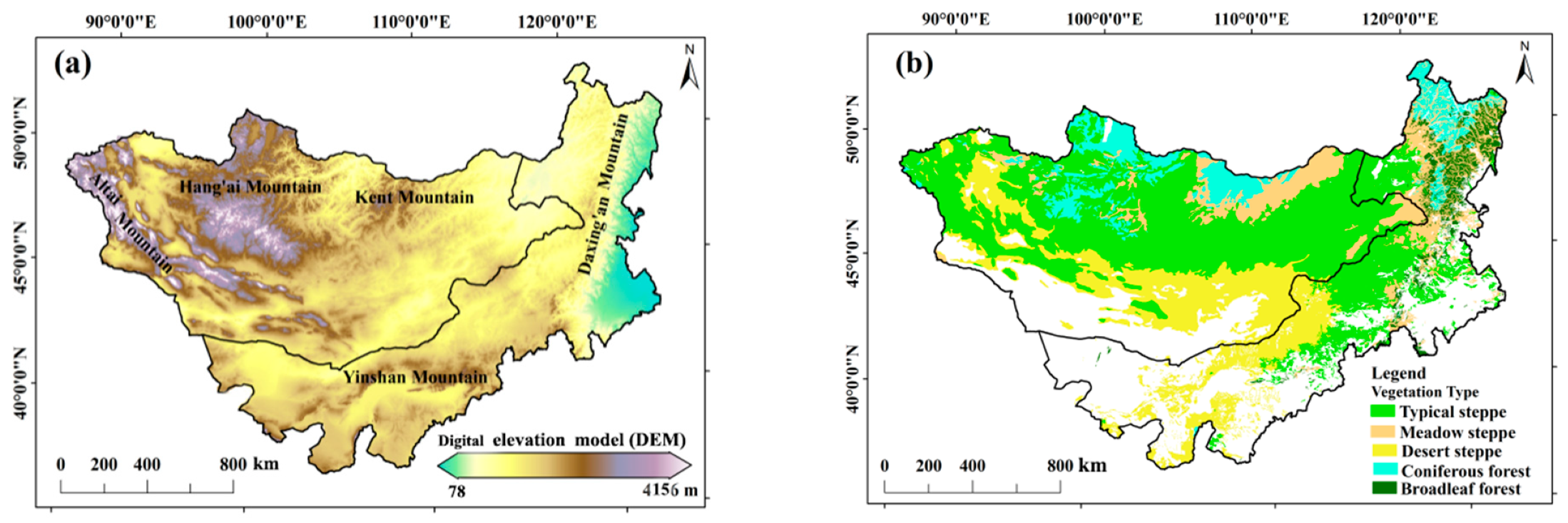
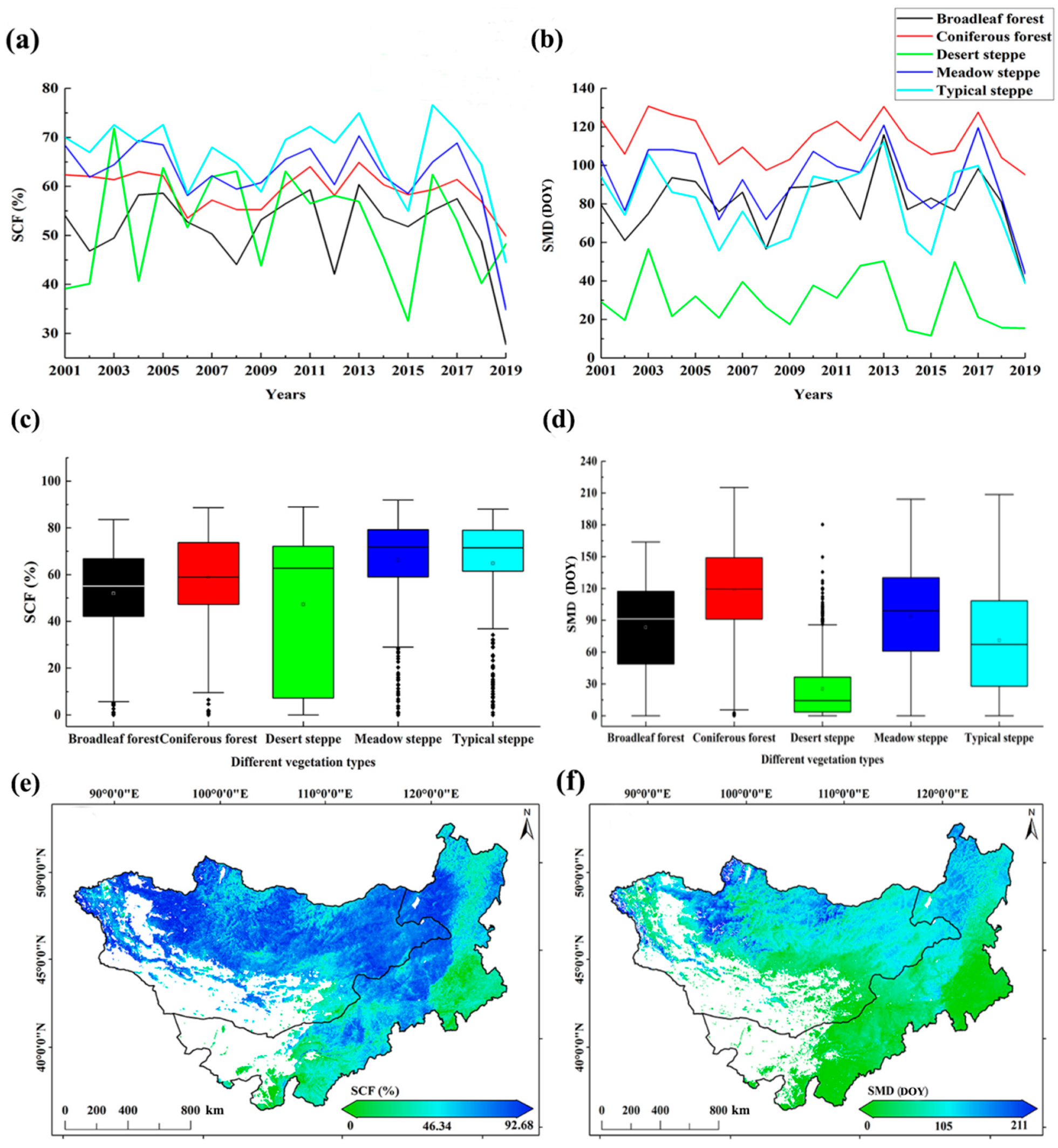
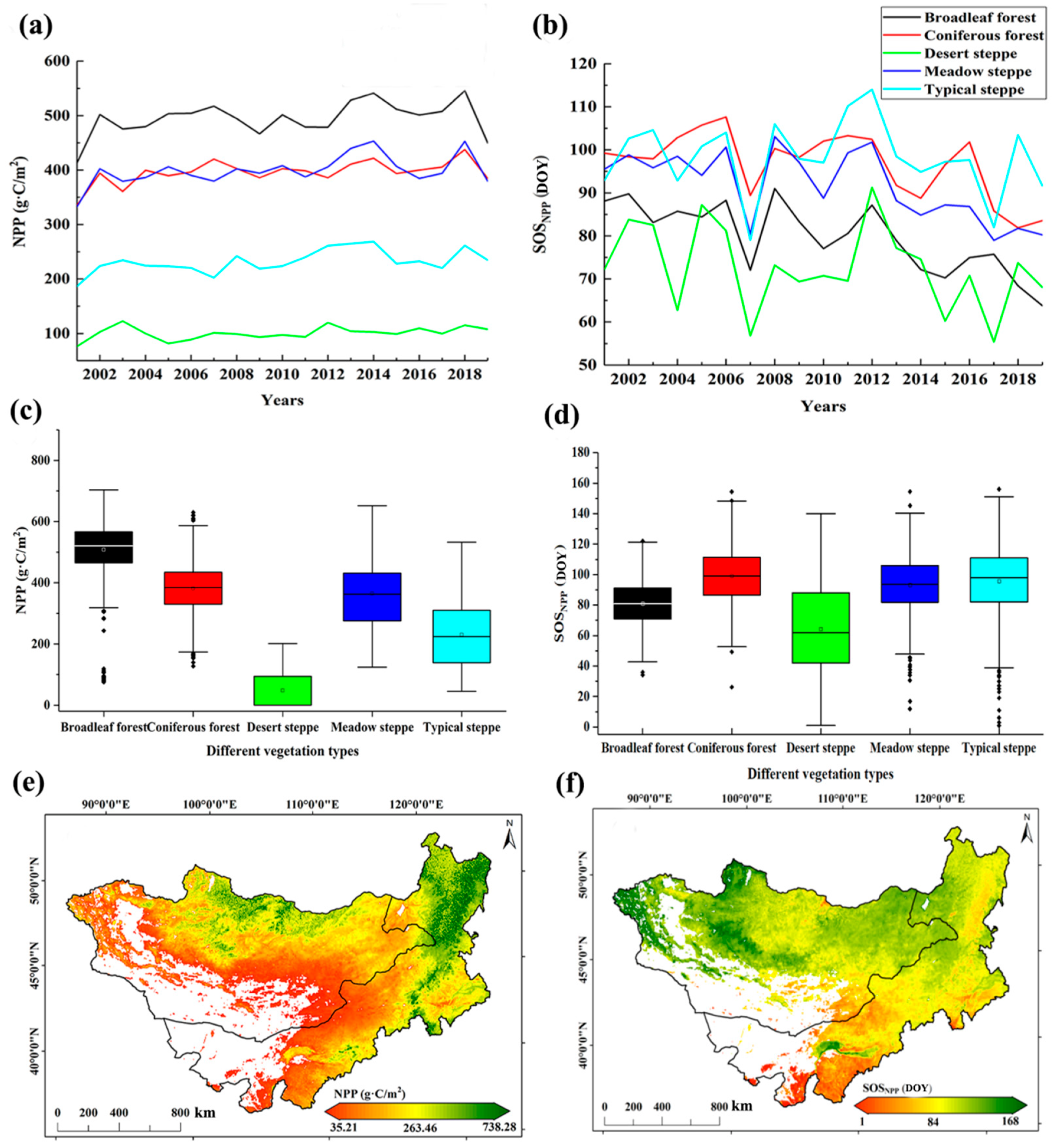
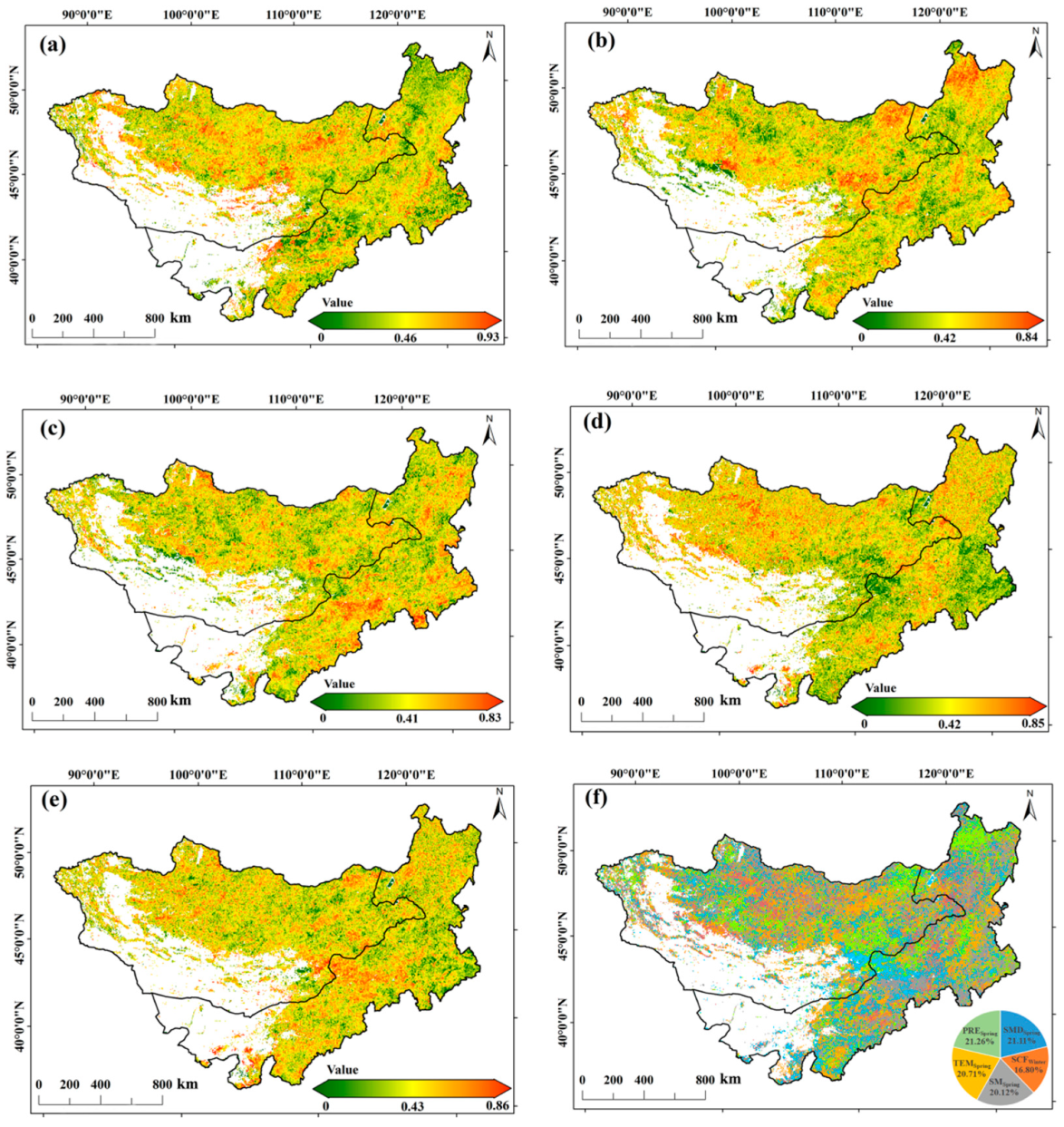
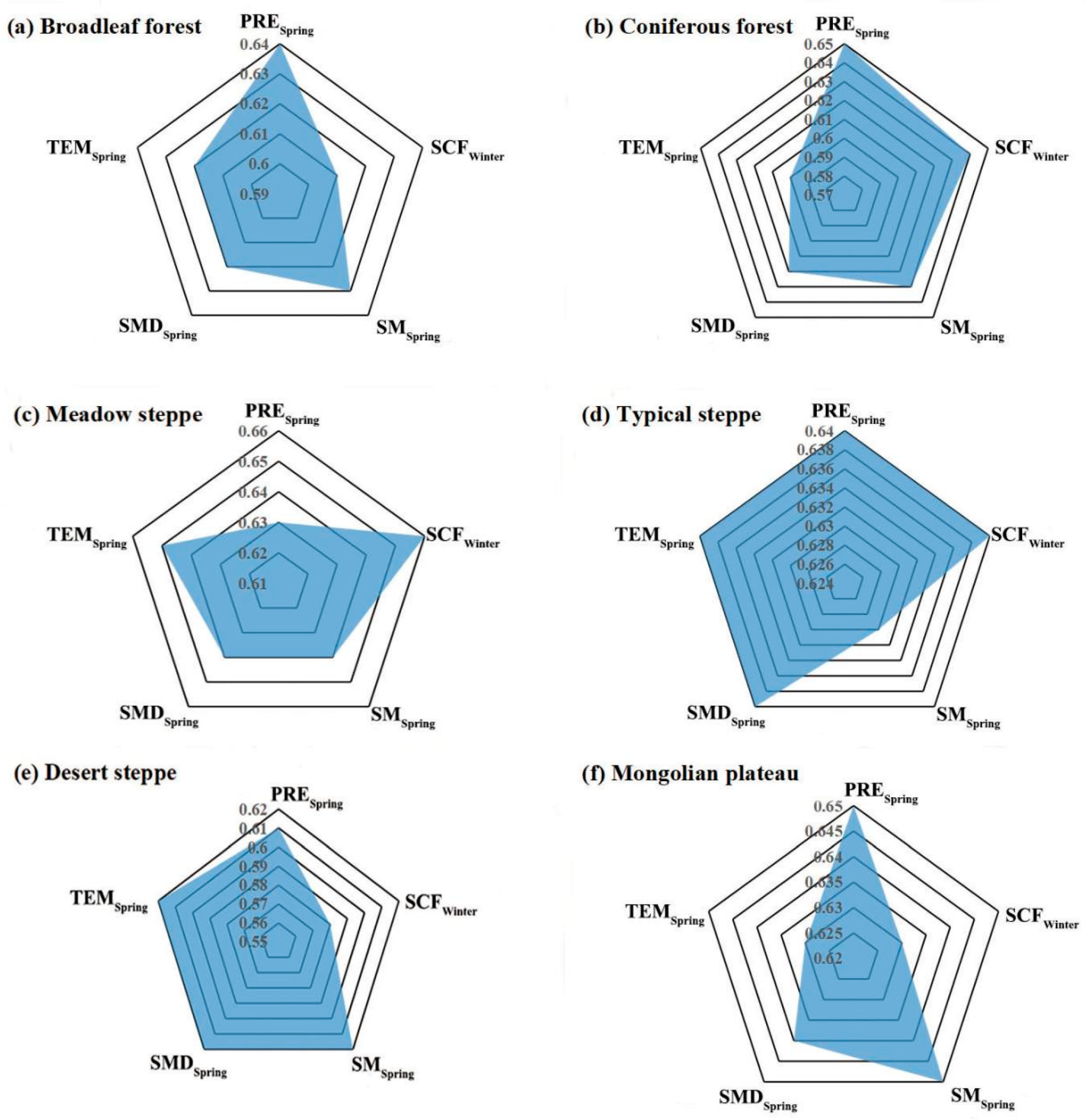

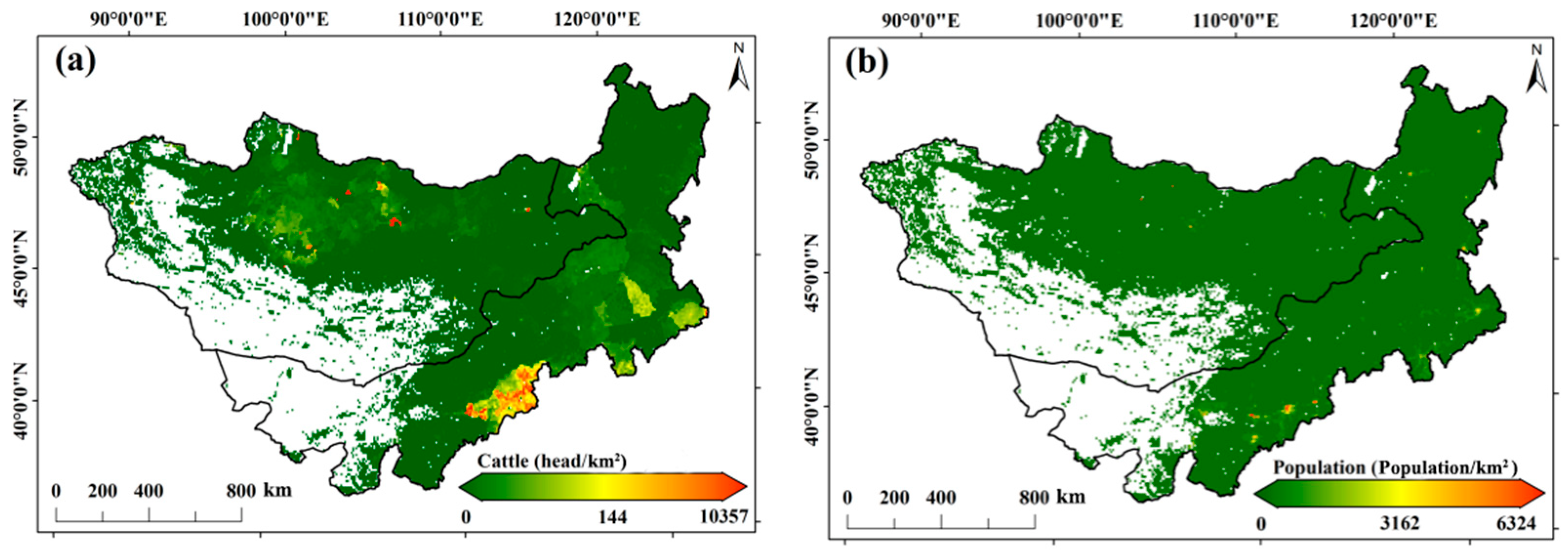
| Number | Vegetation Type | Area (km2) |
|---|---|---|
| 1 | Broadleaf forest | 124,702.25 |
| 2 | Coniferous forest | 352,911.00 |
| 3 | Meadow steppe | 424,664.25 |
| 4 | Typical steppe | 1,640,985.75 |
| 5 | Desert steppe | 750,569.75 |
| Number | Vegetation Type | |
|---|---|---|
| 1 | Broadleaf forest | 0.692 |
| 2 | Coniferous forest | 0.389 |
| 3 | Meadow steppe | 0.654 |
| 4 | Typical steppe | 0.553 |
| 5 | Desert steppe | 0.511 |
Disclaimer/Publisher’s Note: The statements, opinions and data contained in all publications are solely those of the individual author(s) and contributor(s) and not of MDPI and/or the editor(s). MDPI and/or the editor(s) disclaim responsibility for any injury to people or property resulting from any ideas, methods, instructions or products referred to in the content. |
© 2023 by the authors. Licensee MDPI, Basel, Switzerland. This article is an open access article distributed under the terms and conditions of the Creative Commons Attribution (CC BY) license (https://creativecommons.org/licenses/by/4.0/).
Share and Cite
Zhang, X.; Sa, C.; Hai, Q.; Meng, F.; Luo, M.; Gao, H.; Zhang, H.; Yin, C.; Zhang, Y.; Sun, H. Quantifying the Effects of Snow on the Beginning of Vegetation Growth in the Mongolian Plateau. Remote Sens. 2023, 15, 1245. https://doi.org/10.3390/rs15051245
Zhang X, Sa C, Hai Q, Meng F, Luo M, Gao H, Zhang H, Yin C, Zhang Y, Sun H. Quantifying the Effects of Snow on the Beginning of Vegetation Growth in the Mongolian Plateau. Remote Sensing. 2023; 15(5):1245. https://doi.org/10.3390/rs15051245
Chicago/Turabian StyleZhang, Xiang, Chula Sa, Quansheng Hai, Fanhao Meng, Min Luo, Hongdou Gao, Haochen Zhang, Chaohua Yin, Yuhui Zhang, and Hui Sun. 2023. "Quantifying the Effects of Snow on the Beginning of Vegetation Growth in the Mongolian Plateau" Remote Sensing 15, no. 5: 1245. https://doi.org/10.3390/rs15051245
APA StyleZhang, X., Sa, C., Hai, Q., Meng, F., Luo, M., Gao, H., Zhang, H., Yin, C., Zhang, Y., & Sun, H. (2023). Quantifying the Effects of Snow on the Beginning of Vegetation Growth in the Mongolian Plateau. Remote Sensing, 15(5), 1245. https://doi.org/10.3390/rs15051245






